The beginning of this period is generally characterized by an even more marked isolation of the plateau than earlier, while the latter half of the period is one of major new disruptions, heretofore unique in Iranian history, that laid the groundwork for developments in the protohistoric period. In northwestern and central western Iran, local cultures, as yet barely defined beyond their ceramic parameters, developed in relative isolation from events elsewhere. All occupation had ceased at Tepe Sialk, but the painted pottery cultures characteristic of earlier Hissar and of the sites in the Gorgān lowland in the northeast continued. Little Mesopotamian influence is evident, though some contacts between Elam and the plateau remained. Beginning perhaps as early as 2400 BC but more probably somewhat later, a radical transformation occurred in the culture of the northeast: earlier painted potteries were entirely replaced by a distinctive gray or gray-black ceramic associated with a variety of other artifacts, primarily weapons and ornaments in copper or bronze, which were also unique. Whether this cultural change represents a strictly local development or testifies to an important intrusion of new peoples into the area is still under debate. In any case, none of these developments can be traced to Mesopotamia or to other areas to the west, regions which had previously been the sources of outside influences on the Iranian plateau (Source: Britanica).


 Ancient Persia: Pre-historic Developments
Ancient Persia: Pre-historic Developments














































